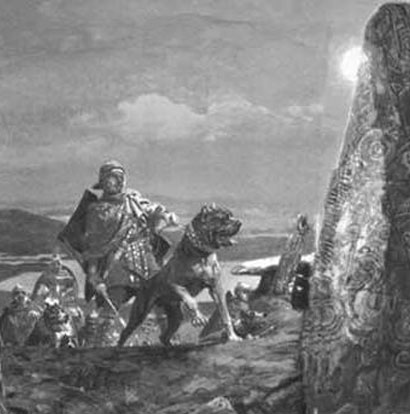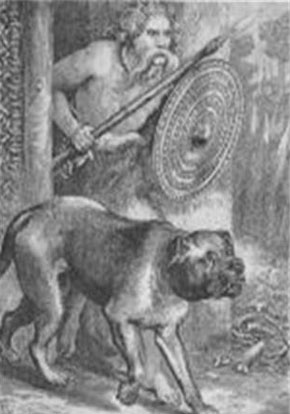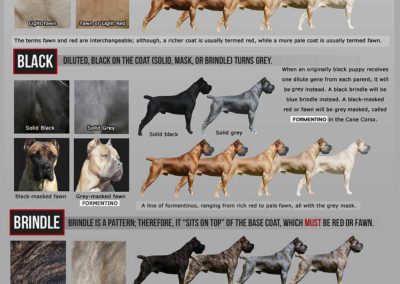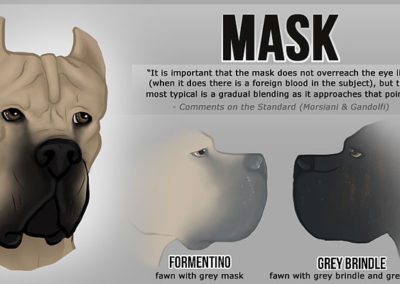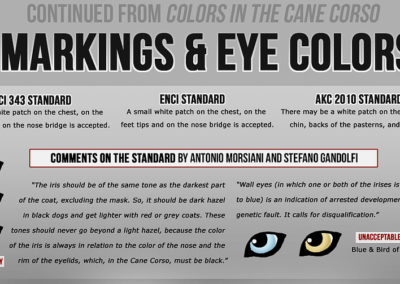SICILIANO CANE CORSO
....for the love of the breed

CANE CORSO
Breed Description:
A large dog, the Cane Corso (pronounced kah-nay cor-so) is strongly built but elegant breed, with powerful and long muscles. They are very distinguished dogs. A Cane Corso expresses strength, agility and endurance. The general conformation of the Cane Corso is that of a mesomorphic animal whose body is longer than the height at the withers. They are harmonious in regards to the form and disharmonious in regards the profile. The Italian Mastiff, as it is called sometimes, is an even tempered breed with a wide head and square jaw. They often have an undershot jaw, and ears can be cropped or left to drop. In countries where cropping is legal, the ears are cropped to a very short point to appear more threatening. They are good guard and watchdogs, and will be very protective of their family. They are normally quiet and very trainable. They remain very wary of strangers and are unafraid of guarding their owner. They are intelligent, aloof, and affectionate with family. They are fine with staying outside, and will need regular exercise. With training and socialization they are good with other pets and people.
- Other Names: Italian Mastiff, Sicilianos Branchiero, Cane di Macellaio, Italian Corso Dog, Italian Molosso.
- Height: 22 – 28 inches.
- Weight: 80 – 140 lbs.
- Colors: Black, Fawn, Brindle, Blue, Formentino, and Blue Brindle. Black or grey mask only on the muzzle and shouldn’t go beyond the eye line. A small white patch on the chest, on the feet tips is accepted.
- Coat: Short hair but not smooth, with vitreous texture, shiny, adherent, stiff, very dense, with a light layer that becomes thicker in winter (but never crops up on the covering hair).
- Health Issues: Hip and elbow dysplasia, gastric torsion (AKA Bloat, or Twisted Stomach), and Demodex Mange (Red mange). Other health concerns include heart disorders, torn cruciates, eyelid abnormalities, Cherry eye, ectropion and entropion.
- Life Span: 10 – 11 years.
- Litter Size: Larger
- Country of Origin: Italy (Sicily)
- History: Cane Corsos are direct ancestor to the old Roman Molossian and cousin to the Neapolitan Mastiff. In the recent past preserved and prevalent in the provinces of Foggia and Ban. Their name derives from the Latin “cohors”, which means “protector, guardian of the farm-yard”, whereas Corso in Italian means “dog”. Originating in the 1600s, the breed was a recreation of an older breed of the Italy, the Cane di Macellaio. It was actually developed on Sicily, not the mainland of Italy. They were used by butchers to drove cattle, guard the farmland and hunt large predators. After World War II, like many other breeds, this breed almost died out. Thanks to fans in the 1980s, though, the breed made a comeback to a world which now holds them in high favor.
- Class: Working
- Registries: ARBA, FCI (Group 2), FSS (Foundation Stock Service), ICCF, AKC
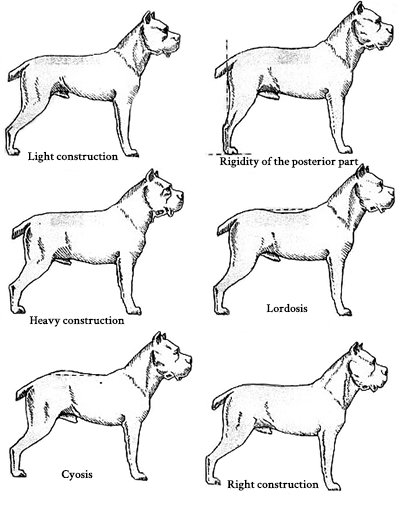
- Temperament: Cane Corsos are loyal, protective, and don’t drool as much as other mastiffs. They are protective and aloof with strangers, remaining very wary of them. They are excellent guards and watchdogs, and are robust in appearance as well as performance. They are usually quiet, affectionate, and caring of their family, including children. They are very intelligent and keep their eyes on strangers.
- With Children: Yes, as long as they are socialized. They are caring of children who are in their family, but aloof with strangers.
- With Pets: Yes, as long as they are socialized.
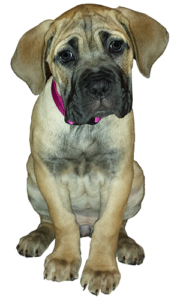
- Watch-dog: High. Cane Corsos make excellent watchdogs.
- Guard-dog: High. Cane Corsos make excellent guard dogs. They were originally bred to be guards and drivers.
- Care and Exercise: Cane Corsos need regular exercise. They should be checked for eye problems and other health concerns.
- Training: Training is essential for the Cane Corso, otherwise they may become protective and aggressive towards even welcomed strangers. They should be trained not to be aggressive around friends and other pets. Socialization is a must when they are puppies.
- Special Needs: Fenced yard, a leash, socialization and training.
- Learning Rate: High. Cane Corsos are very intelligent.
- Activity: Medium.
- Living Environment: Cane Corsos need a yard with a fence at their owner’s house. They need space, since they are a large dog, and require some kind of daily exercise. The best owner for this type of dog would be a guardian dog-experience owner in a rural or suburban home, but they can live in an apartment if given enough exercise.
Brief Historical Summary
Its direct ancestor is the “Canis Pugnax” (the old Roman Molossian) of which he is the light version employed in the hunting of large wild animals and also as an “auxiliary warrior” in battles. For years he has been a precious companion of the Italic populations. Employed as property, cattle and personal guard dog and used for hunting purposes too. In the past this breed was common all over Italy as an ample iconography and historiography testify. In the recent past he has found a excellent preservation area in Southern Italy, expecially in Puglia, Lucania and Sannio. His name derives from the Latin “Cohors” which means “Guardian”, “Protector”

“Canis Pugnax” (the old Roman Molossian)
